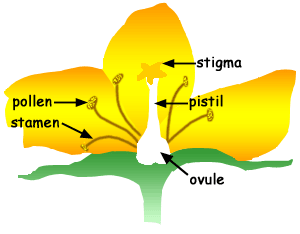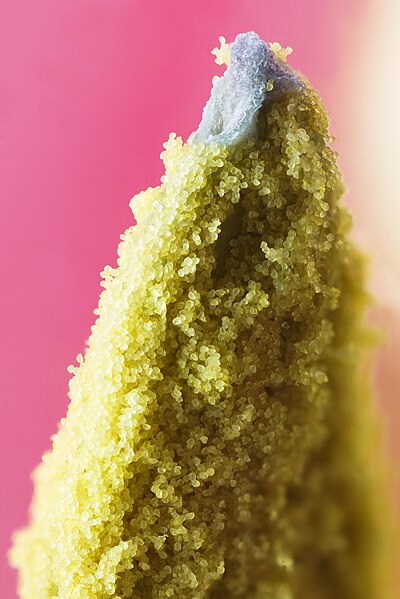Pollination refers only to the transfer of male gametes i.e. pollen grains from the male reproductive structure of the flower (anther) to the female reproductive structure of the flower i.e. stigma of ovary.
When the two gametes- male(pollen grains) and female(egg) meet or fuse with each other, it is called fertilisation.
- 0
Pollination is very important. It leads to the creation of new seeds that grow into new plants. To be pollinated, pollen must be moved from a stamen to the stigma. When pollen from a plant's stamen is transferred to that same plant's stigma, it is called self-pollination. When pollen from a plant's stamen is transferred to a different plant's stigma, it is called cross-pollination. Cross-pollination produces stronger plants. The plants must be of the same species. For example, only pollen from a daisy can pollinate another daisy. Pollen froma rose or an apple tree would not work. But how does pollination work? Well, it all begins in the flower. Flowering plants have several different parts that are important in pollination. Flowers have male parts called stamens that produce a sticky powder called pollen. Flowers also have a female part called the pistil. The top of the pistil is called the stigma, and is often sticky. Seeds are made at the base of the pistil, in the ovule.
But how does pollination work? Well, it all begins in the flower. Flowering plants have several different parts that are important in pollination. Flowers have male parts called stamens that produce a sticky powder called pollen. Flowers also have a female part called the pistil. The top of the pistil is called the stigma, and is often sticky. Seeds are made at the base of the pistil, in the ovule.
- 0
Pollination is the process by which pollen is transferred in plants, thereby enabling fertilization and sexual reproduction. Pollen grains, which contain the male gametes (sperm) to where the female gamete(s) are contained within the carpel;[1] in gymnosperms the pollen is directly applied to the ovule itself. The receptive part of the carpel is called a stigma in the flowers of angiosperms. The receptive part of the gymnosperm ovule is called the micropyle. Pollination is a necessary step in the reproduction of flowering plants, resulting in the production of offspring that are genetically diverse.
- 1
Pollination is the process by which pollen is transferred in plants, thereby enabling fertilization and sexual reproduction. Pollen grains, which contain the male gametes (sperm) to where the female gamete(s) are contained within the carpel in gymnosperms the pollen is directly applied to the ovule itself. The receptive part of the carpel is called a stigma in the flowers of angiosperms. The receptive part of the gymnosperm ovule is called the micropyle. Pollination is a necessary step in the reproduction of flowering plants, resulting in the production of offspring that are genetically diverse.
The study of pollination brings together many disciplines, such as botany, horticulture, entomology, and ecology. The pollination process as an interaction between flower and vector was first addressed in the 18th century by Christian Konrad Sprengel. It is important in horticulture and agriculture, because fruiting is dependent on fertilisation, which is the end result of pollination.







- 1
Pollination is the process by which pollen is transferred in plants, thereby enabling fertilization and sexual reproduction. Pollen grains, which contain the male gametes (sperm) to where the female gamete(s) are contained within the carpel;[1] in gymnosperms the pollen is directly applied to the ovule itself. The receptive part of the carpel is called a stigma in the flowers of angiosperms. The receptive part of the gymnosperm ovule is called the micropyle. Pollination is a necessary step in the reproduction of flowering plants, resulting in the production of offspring that are genetically diverse.
The study of pollination brings together many disciplines, such as botany, horticulture, entomology, and ecology. The pollination process as an interaction between flower and vector was first addressed in the 18th century by Christian Konrad Sprengel. It is important in horticulture and agriculture, because fruiting is dependent on fertilisation, which is the end result of pollination.
- 0
Pollination is the process by which pollen is transferred in plants, thereby enabling fertilization and sexual reproduction. Pollen grains, which contain the male gametes (sperm) to where the female gamete(s) are contained within the carpel; [1] in gymnosperms the pollen is directly applied to the ovule itself. The receptive part of the carpel is called a stigma in the flowers of angiosperms. The receptive part of the gymnosperm ovule is called the micropyle. Pollination is a necessary step in the reproduction of flowering plants, resulting in the production of offspring that are genetically diverse.
The study of pollination brings together many disciplines, such as botany, horticulture, entomology, and ecology. The pollination process as an interaction between flower and vector was first addressed in the 18th century by Christian Konrad Sprengel. It is important in horticulture and agriculture, because fruiting is dependent on fertilisation, which is the end result of pollination.
- 0



